The Ham Funeral
A mothbally but delightful history lesson in Australian theatre.
Overview
Patrick White's 1947 play, The Ham Funeral has dated, and that's a good thing. Seeing the piece in all its mothbally shabbiness is a history lesson in Australian theatre. White was one of the first Australian playwrights to start experimenting with form, and the metanarrative of the Young Man protagonist may seem twee now but was innovative for its time. The play is also full of glorious, carnal language. White's ability to combine narrative drive alongside arresting poetry is satisfying.
Our protagonist, the Young Man (Rob Baird), is a floundering poet boarding in the greying, linoleum-floored and dank boarding house of Mr and Mrs Lusty. Mr Lusty (Zach McKay) is a truculent sort who, seeming half dead to begin with, delivers some fabulous vitriol to his bawdy wife before promptly expiring fairly early on in the piece. McKay's performance here is suitably sour and we believe Mrs Lusty (Lucy Miller) when she tells him his "mouth is foul with silence". Mrs Lusty declares they must have a ham funeral, and so begins the vulgar, dark comedy. Miller playing the "smudgy, sludgy" Mrs Lusty is tawdry yet poised, but the hideousness that the Young Man and Mr Lusty ascribe to her never comes to the fore. The performances are generally strong and director Phillip Rouse has given the text a clear shape, though I might pretend that the dancing before interval never took place.
I'm at a loss to find who designed the stage in the program notes, but whoever it was, props to them (update: it's director Phillip Rouse himself, what a skillset). Because the New Theatre stage is such a barn, too often productions truncate it into a shallow downstage strip presumably to make it more manageable. This designer has used three levels and maximised the depth of the space so that the stage looks positively three-dimensional for once. Sian James-Holland's lighting design is presumably aiming for some sort of edge-of-reality-type shadiness but is just plain dim for much of the show.
Rouse's straightforward interpretation of the play gives us a view of the past and a sense of Australia's theatre legacy. The play is seldom performed, and though it didn't make it onto a Melbourne stage until 2005, it's part of the canon of Australian plays (if we can really talk of such a thing) because it's a great piece of literature.





